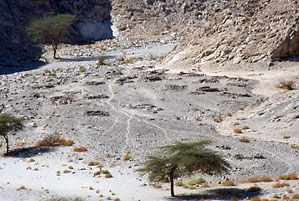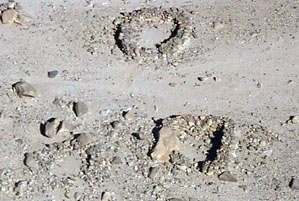|
An overview of Qaria Mustafa 'Amr with
its numerous
simple huts in a dead-end wadi:
|
|
Two of the huts in Qaria Mustafa 'Amr,
one almost
circular, the other rectilinear:
|
|
|
|
|

|
|

|
|
|
|
|
|
|
|
|
Objective of visit:
|
|
To draw a measured plan
of the site and study the surface
remains (including the ceramic finds). |
|
Date of visit:
|
|
- January 2000 |
|
Fellow visitors:
|
|
Prof.Dr. Steve Sidebotham
(University of Delaware), Barbara
Tratsaert and Veerasamy Selvakumar (Berenike Project). |
| Results: |
|
A survey was performed
using the Global Positioning System,
a theodolite and steel tape measures. Off-site assistance was given by
pottery expert Dr. Roberta Tomber (Museum of London). No excavations
took
place. Our plans and description were published
in: S.E. Sidebotham, H.
Barnard and G. Pyke; Five enigmatic late Roman settlements in the
Eastern Desert; Journal of Egyptian
Archaeology 2002; vol. 88: pp. 187-225. |
| Approximate position and date
of the site: |
|
Qaria Mustafa 'Amr in
Wadi Umm Atlee is in the far south-east of the Egyptian Eastern desert,
close to the Egyptian-Sudanese border.
Surface pottery
dated to the late Roman period (ca. 300 - 600 AD). |
| Short description of the site: |
|
Qaria Mustafa 'Amr was a
large settlement of simple huts,
far from any ancient roads, mines or quarries. Surface finds were
limited
to potsherds and the function of the settlement remains enigmatic. |
| Additional remarks: |
|
The reason for the
existence of Qaria Mustafa 'Amr might
have been the hunting or gathering of yet unknown commodities or the
temporary
residence for political or religious refugees. Our work was sponsored
by
the Berenike Project and private donors. |
| HOME |
|
|
 |
|
|